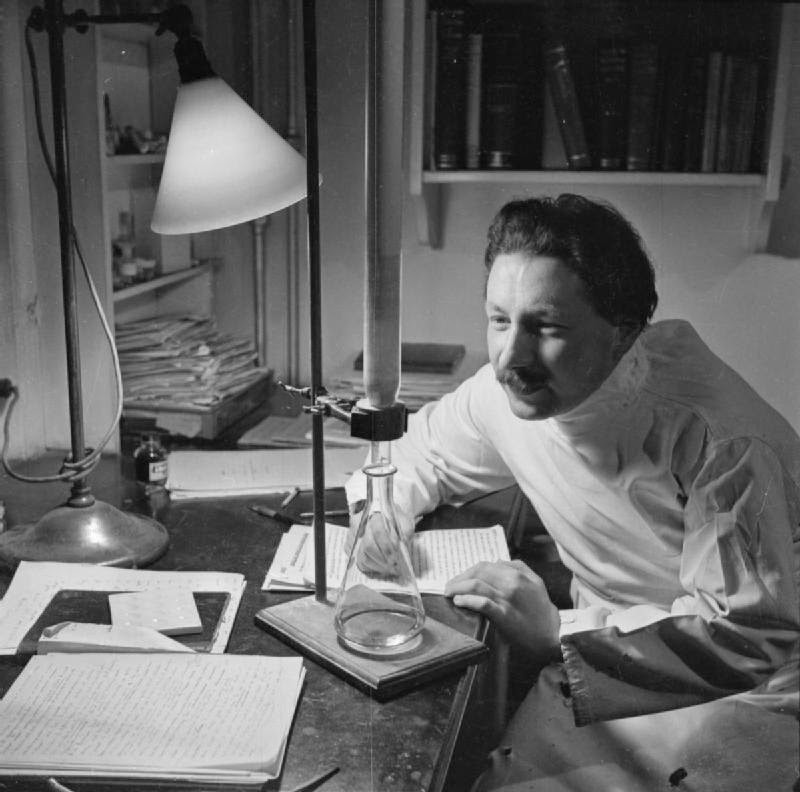
Sir Ernst Boris Chain (1906-1979)
On June 19, 1906, German-born British biochemist and Nobel Laureate Sir Ernst Boris Chain was born. He is best known for being one of the founders of chemical and medical research on antibiotics, esp. on Penicillinum.
“Science, as long as it limits itself to the descriptive study of the laws of nature, has no moral or ethical quality and this applies to the physical as well as the biological sciences.” (Sir Ernst Boris Chain, in ‘Social Responsibility and the Scientist’, New Scientist, 22 October 1970, 166.)
Background Ernst Boris Chain
Ernst Boris Chain was born in Berlin, the son of Margarete (née Eisner) and Michael Chain, a Russian-born Jewish immigrant who became a chemical engineer and built a successful chemical plant. The death of Michael Chain in 1919, coupled with the collapse of the post-World War I German economy, depleted the family’s income so much that Margarete Chain had to open up her home as a guesthouse. One of Chain’s primary interests during his youth was music, and for a while it seemed that he would embark on a career as a concert pianist. Ernest B. Chain was educated at the Luisengymnasium, Berlin, where he soon became interested in chemistry, stimulated by visits to his father’s laboratory and factory. He next attended the Friedrich-Wilhelm University, Berlin, where he graduated in chemistry in 1930. He was from an early age interested in biochemistry and after graduation he worked for three years at the Charité Hospital, Berlin, on enzyme research.[3]
England
After the Nazis came to power, Chain knew that he, being Jewish, would no longer be safe in Germany. He left Germany and moved to England, arriving on 2 April 1933. Geneticist and physiologist J.B.S Haldane helped him obtain a position at University College Hospital, London.[4] He began working on phospholipids (a major component of all major biological membranes) as a PhD student at Fitzwilliam House, Cambridge University under the direction of Sir Frederick Gowland Hopkins.[5] In 1935, he accepted a job at Oxford University as a lecturer in pathology. During this time he worked on a range of research topics, including snake venoms, tumor metabolism, lysozymes, and biochemistry techniques.
Antibiotic Research
In 1939, he joined Howard Florey to investigate natural antibacterial agents produced by microorganisms – among them penicillin. This led him and Florey to revisit the work of Alexander Fleming, who had described penicillin nine years earlier.[6] They mistakenly thought these substances were all enzymes like lysozyme. While Florey and Chain were assembling grants to support their research, work was begun on penicillin. Chain and Florey went on to discover penicillin’s therapeutic action and its chemical composition. He also theorized the structure of penicillin, which was confirmed by X-ray crystallography done by Dorothy Hodgkin.[7] For this research, Chain, Florey, and Fleming received the Nobel Prize in 1945. Chain, along with another chemist, Edward Penley Abraham, worked out a successful technique for purifying and concentrating penicillin. The keys seemed to lie in controlling the pH of the “juice,” reducing the sample’s temperature, and evaporating the product over and over (essentially freeze-drying it). In this early process many gallons of mold broth were used to produce an amount just large enough to cover a fingernail. This excruciatingly inefficient process was later improved on by Norman Heatley — another biochemist on the research team assembled by Florey — and a succession of other scientists.
After World War II
Towards the end of World War II, Chain learned his mother and sister had perished in the war. Soon after World War II, Chain moved to Rome, to work at the Istituto Superiore di Sanità (Superior Institute of Health). There, he productively combined a biochemical research department and a fermentation pilot plant. In 1957 a consulting relationship with a group of scientists from the Beecham Group, who came to Rome especially to benefit from Chain’s biochemical insights and the facilities there, resulted in the isolation of the atomic groupings central to the penicillin molecule. He returned to Britain in 1964 as the founder and head of the biochemistry department at Imperial College London, where he stayed until his retirement, specializing in fermentation technologies. In honor of his scientific achievements he was knighted soon after in 1969. Always a person of many interests and projects, in his later life, his Jewish identity became increasingly important to him. He became a member of the board of governors of the Weizmann Institute of Science in 1954, and later a member of the executive council. His views were expressed most clearly in his speech ‘Why I am a Jew’ given at the World Jewish Congress Conference of Intellectuals in 1965.
Lucy Shapiro (Stanford Univ) Part 2: Escalating Infectious Disease Threat, [9]
References and Further Reading:
- [1] Ernest B. Chain at Nobelprize.org
- [2] Howard Walter Florey and Ernest Boris Chain at Chemical Heritage Foundation
- [3] Charité Hospital, Berlin Website
- [4] J. B. S. Haldane and population Genetics, SciHi blog
- [5] Sir Frederick Gowland Hopkins and the Discovery of Vitamins, SciHi Blog
- [6] Alexander Fleming and the Penicillin, SciHi Blog
- [7] Dorothy Hodgkin and the Structure of Penicilin, SciHi Blog
- [8] Ernst Boris Chain at Wikidata
- [9] Lucy Shapiro (Stanford Univ) Part 2: Escalating Infectious Disease Threat, iBiology @ youtube
- [10] Abraham, Edward (1983). “Ernst Boris Chain. 19 June 1906 – 12 August 1979”. Biographical Memoirs of Fellows of the Royal Society. 29: 42–91.
- [11] Mansford, K. R. (1979). “Sir Ernst Chain, 1906-1979”. Nature. 281 (5733): 715–717.
- [12] Abraham, E. P. (1979). “Obituary: Sir Ernst Boris Chain”. The Journal of Antibiotics. 32 (10): 1080–1081.
- [13] Timeline for Ernst Boris Chain, via Wikidata





